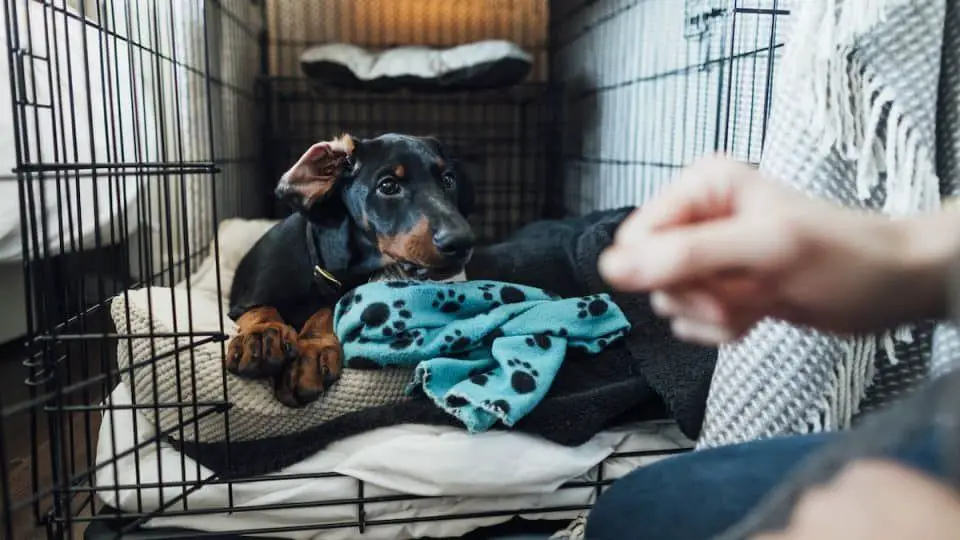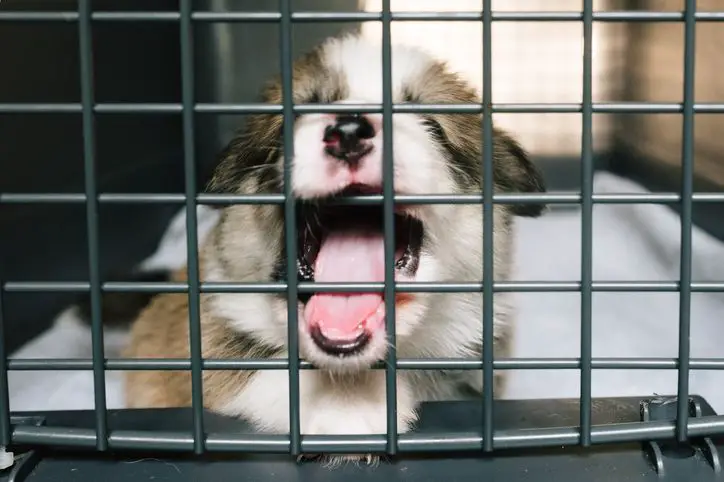Introduction
Crates are enclosures often used for house training, confining, and transporting dogs. They provide a safe, enclosed space for dogs when their owners cannot supervise them. Crates come in different sizes to accommodate dogs of all ages. While crates can be very useful tools for dog owners, their use raises questions about whether crating is humane and under what circumstances.
History of Crates
The use of crates for dogs dates back hundreds of years. Crates were originally used by hunters to transport dogs during hunts and provide a safe space for the dogs to rest between activities. In the past, dog crates were basic wooden boxes or wire cages designed to confine dogs while traveling or keep them out of trouble around the home.
Crates have traditionally served practical purposes like potty training puppies, preventing destructive behaviors, and providing dogs a comfortable and secure den space. The instinct for dogs to seek out sheltered spaces traces back to their wolf ancestors who would rest in dens. Thus, crates tap into this natural denning behavior in dogs.
While crates have been used for centuries, the acceptance and popularity of crating dogs in the home and as an everyday training tool is a more modern development. As knowledge about canine behavior and training has grown, crates have become mainstream for house training puppies and managing dogs safely and humanely.
Benefits of Crates
Crates can provide several benefits for dogs when used properly. Here are some of the main advantages of crate training:
Providing Security: Crates give dogs their own safe, private space where they can relax and feel secure. This den-like atmosphere can reduce stress and anxiety in dogs who are nervous by nature. The enclosed crate helps shy or anxious dogs feel more comfortable.
Reducing Anxiety: The crate prevents dogs from wandering and getting into trouble while owners are away, which can cause anxiety. Dogs are den animals by nature and often seek out small, enclosed spaces to sleep and rest. The crate mimics this natural instinct. Knowing their crate is available can help ease separation anxiety.

House Training Aid: Because dogs naturally avoid soiling in their sleeping area, crates can speed up the housebreaking process by preventing indoor accidents. Crated dogs learn to “hold it” until let outside for potty breaks. Using the crate properly teaches good bladder control.
Concerns About Crates
While crates can be very useful for dog owners, there are some concerns surrounding their use. Critics argue that crating a dog for long periods could be inhumane and detrimental to a dog’s well-being.
The main concerns about crating dogs include:
Confinement – Dogs are naturally active animals and confining them to a small space for hours can cause frustration, anxiety, and stress. Dogs need space to move around and exercise their bodies.
Boredom – Being confined with minimal stimulation for extended periods can lead to boredom and lack of mental stimulation for dogs. This could result in problem behaviors like destructive chewing or excessive barking.
Lack of Exercise – Crates limit a dog’s ability to be physically active and get the exercise they need. Lack of exercise can lead to pent up energy and behavior problems.
While valid concerns, most can be addressed through proper crate training, limiting crating periods, providing toys/chews, exercising before crating, and using crates judiciously. Still, crates shouldn’t be used excessively without meeting a dog’s other needs.
Crate Training Tips
Crate training requires patience and positive reinforcement. Here are some tips for making it a successful and stress-free process for your dog:
Make it a positive space: Place blankets and toys inside so your dog associates it with comfort. Feed them in the crate so they see it as a rewarding place. Start by leaving the door open so they explore it freely.

Ensure proper sizing: Your dog should be able to stand up, turn around, and lie down comfortably. Too much space can lead to accidents. Measure your dog and choose a crate designed for their size.
Provide enrichment: Safe, interactive toys will keep your dog mentally stimulated. Food puzzles, frozen Kongs, and chew toys are great for crated pups. Rotate different enrichments to prevent boredom.
With positive associations, proper sizing, and mental enrichment, the crate becomes a relaxing retreat for your dog’s naps and quiet time. Be patient during training, never force your dog inside, and make it a happy experience.
When to Use Crates
Crates can be extremely useful in certain situations when used properly. Here are some of the most common times when crating your dog can be appropriate:
At Night
Many dog owners crate their dogs at night for sleeping. This gives the dog a safe, cozy space that is just for them. It can help anxious dogs feel more secure and prevent nighttime wandering or getting into trouble while the owners sleep.
When Away
Crates are often used to contain dogs safely when the owner is away at work, running errands, or out of the house. The crate prevents the dog from potentially injuring itself or destroying furniture and belongings. It also protects the dog from hazards like household chemicals, plants, medications, or electric cords.
During Travel
Transporting a dog in a crate is the safest method for car or air travel. Properly secured crates protect the dog and prevent driver distraction. Crates may be required for air travel or staying in pet-friendly hotels.
For Anxious Dogs
Some dogs feel calmer and less stressed in a crate, especially if crate training is done properly. It can provide a sense of security and structure for dogs with separation anxiety. Crates may also be used for short periods for dogs that are fearful of noises, visitors, or other stimuli.
Alternatives to Crates
While crates can be useful for some dogs in certain situations, there are other options to consider that allow your dog more freedom while still keeping them secure:
Baby Gates
Baby gates allow you to partition off rooms and block access to areas you don’t want your dog to get into. They can be used to keep your dog in a “dog proof” area while you’re gone or at night. Look for tall, sturdy gates that your dog won’t be able to jump over.
Dog Proofed Room
You can “dog proof” a room in your home by removing anything your dog shouldn’t chew and blocking access to unsafe areas. This allows your dog to freely move around while keeping them safely contained. Make sure to pick up electrical cords, remove trash, and cover or block access to any unsafe spaces.
Outdoor Kennels
For dogs that need to be confined when you’re not home, an outdoor kennel may be a good alternative. Make sure to choose a kennel with ample space and shelter from the elements. Only use an outdoor kennel if you can frequently check on your dog while away.
Signs of Improper Crating
When used improperly, crating dogs can lead to anxiety, injury, and other problems. Here are some signs that crating may be negatively impacting your dog’s well-being:
Anxiety: Excessive barking, howling, whimpering, panting, pacing, and attempts to escape the crate can indicate separation anxiety or confinement distress. Dogs under extreme stress may even injure themselves trying to get out.

Injury: Dogs may rub their face raw or break teeth trying to chew their way out. Muscle strains and ligament tears are also possible from attempting to escape. Pressure sores, calluses, and cuts can develop from prolonged contact with the crate surface.
Soiling the Crate: Urinating or defecating in the crate, especially in a previously house-trained adult dog, suggests the dog was confined too long and couldn’t hold it. Puppies may also soil crates if confined beyond their bladder capacity.
Destruction: Chewed up beds, bent wires, and scratched walls show an improperly acclimated or anxious dog. Dogs may try to escape or take out frustration on crate contents.
Guidelines for Humane Use
There are several key guidelines to follow to ensure crates are used humanely:
Proper sizing – Crates should be large enough for your dog to stand up, turn around, and lie down comfortably. However, too much extra space can undermine the benefits of crating.
Enrichment – Include safe chew toys in the crate to provide mental stimulation. You can also place treats or a portion of their food in puzzle toys. Rotate different enrichment items to prevent boredom.
Short term use – Crates should mainly be used for short-term confinement, such as when you are away, sleeping, or can’t supervise. Dogs shouldn’t be crated for excessively long periods.
Monitoring – Check on your dog frequently when crated to ensure they are not in distress. Look for signs of anxiety or injury that may warrant discontinuing crating.
Following these guidelines can help ensure crating is done in a way that is safe and humane for dogs. Proper use allows dogs to benefit from the security and structure crates provide.
Conclusion
In conclusion, crating dogs can be a humane practice when done properly and for limited amounts of time. The key is to create a comfortable space for your dog and use crates as a training tool, not a punishment. Make sure your dog gets plenty of exercise, socialization and affection outside of the crate. Never use crates to neglect your dog’s needs. With proper guidelines, crate training can provide benefits like potty training, reduced separation anxiety and a safe space for your dog when you can’t supervise them. However, crates are not a substitute for walks, play and quality time together. Be mindful of your dog’s age, health issues and temperament when deciding how much time in a crate is appropriate. Alternatives like baby gates and penned areas can also give your dog space while allowing more movement. The wellbeing of dogs should always come first. With thoughtful training methods and care, crates can be a useful tool that does not compromise your pet’s happiness.